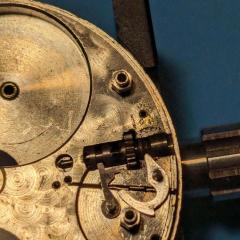Removing dial from Omega Constellation Cal. 654
-
Recently Browsing
- No registered users viewing this page.
-
Topics
-
Posts
-
I used to have a lecturer during my Engineering classes who was always beating a drum about quoting units, I remember one day he was so exasperated with our class he said "quote your units!!!!...I don't care what units JUST QUOTE THEM!!!" My next assignment I calculated the velocity and quoted the units, something along the lines of: "Thus the velocity of the body will be 0.00345 furlongs per fortnight" He graded my work as an F, then crossed it out and gave me an A+, turns out he had a sense of humor after all.
-
Just to add to what @Neverenoughwatches says, the impulse jewel on the balance wheel is also held in by shellac, so avoid exposing the assembly to IPA as well - as stated the one-dip and generic tetrachloroethylene equivalent is safe with shellac so you can use this for your pallet fork and balance assembly. I agree, but worth noting that IPA readily soaks up water, even from the atmosphere: "IPA exposed to the air will absorb moisture rapidly until it reaches an equilibrium value of 65% IPA to 35% water." So you need to refresh it regularly.
-
By Neverenoughwatches · Posted
The width is otherwise known as mainspring height and strength as thickness for us more modern guys. -
By RichardHarris123 · Posted
I've remembered something I had forgotten. I've come across Dennison before but forgot all about it as I'm never going to use the units. Maybe we should start a thread on obscure units of measurement. -
Learned a new thing today! 🤓 Looked this up and found this informative document: Watkins-MainspringGauges.pdf
-







Recommended Posts
Join the conversation
You can post now and register later. If you have an account, sign in now to post with your account.
Note: Your post will require moderator approval before it will be visible.